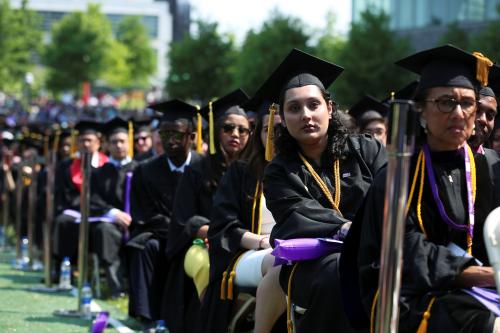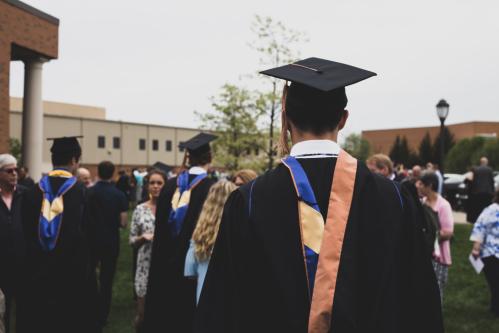Most news stories and reports about student debt cite the fact that Americans owe more than $1.5 trillion. The fact that households in the upper half of the income distribution and those with graduate degrees hold a disproportionate share of that debt almost never makes it into the narrative. But who owes education debt is as important as how much debt there is. Only with this information can we determine who struggles because of their student loans and who is succeeding in the job market because of the education that loans helped them achieve.
Recently released data from the Federal Reserve’s Survey of Consumer Finances confirm that upper-income households account for a disproportionate share of student loan debt—and an even larger share of monthly out-of-pocket student debt payments.
The highest-income 40 percent of households (those with incomes above $74,000) owe almost 60 percent of the outstanding education debt and make almost three-quarters of the payments. The lowest-income 40 percent of households hold just under 20 percent of the outstanding debt and make only 10 percent of the payments. It should be no surprise that higher-income households owe more student debt than others. Students from higher-income households are more likely to go to college in the first place. And workers with a college or graduate degree earn substantially more in the labor market than those who never went to college.
What may be more surprising, however, is the difference in payment burdens. A growing share of borrowers participate in income-driven repayment (IDR) plans, which do not require any payments from those whose incomes are too low and limit payments to an affordable share of income for others. And some borrowers are in forbearance or deferment because of financial hardships. As a result, out-of-pocket loan payments are concentrated among high-income households; few low-income households enrolled in IDR are required to make payments.
Share of debt and of debt payments by income quintile, 2019
 Source: Board of Governors of the Federal Reserve System (2017, 2020), Survey of Consumer Finances 2016 and 2019, https://www.federalreserve.gov/econres/scfindex.htm, calculations by the authors. Sample includes households age 25 or older who are not current students.
Source: Board of Governors of the Federal Reserve System (2017, 2020), Survey of Consumer Finances 2016 and 2019, https://www.federalreserve.gov/econres/scfindex.htm, calculations by the authors. Sample includes households age 25 or older who are not current students.
Likewise, education debt is concentrated in households with high levels of educational attainment. In 2019, the new Fed data show, households with graduate degrees owed 56 percent of the outstanding education debt—an increase from 49 percent in 2016. For context, only 14 percent of adults age 25 or older hold graduate degrees. The 3 percent of adults with professional and doctorate degrees hold 20 percent of the education debt. These households have median earnings more than twice as high as the overall median ($106,000 vs. $47,000 in 2019).
Share of outstanding student debt held by households with different levels of educational attainment, 2016 and 2019
| Share of student debt | ||
| Highest level of education of household head or spouse | 2016 | 2019 |
| No college degree | 13% | 8% |
| AA | 12% | 7% |
| BA | 27% | 29% |
| MA | 27% | 36% |
| Professional/Doctoral | 21% | 20% |
Source: Board of Governors of the Federal Reserve System (2017, 2020), Survey of Consumer Finances 2016 and 2019, https://www.federalreserve.gov/econres/scfindex.htm, calculations by the authors.
In general, how much debt people owe is not a good indication of their financial or socioeconomic status. It depends on what type of debt they have. Few financially secure households take payday loans, allow their utility bills to go unpaid, or accumulate large amounts of medical debt. But the least well-off households don’t qualify for mortgages or invest in businesses, so they don’t have housing debt or business loans.
Many of the lowest-income households consist of adults who did not go to college and thus have little education debt. Their lack of college credentials makes it difficult for them to find well-paying jobs with reliable career paths. In 2019, 44 percent of adults with earnings below the median of $47,500 had no education beyond high school, compared with just 19 percent of those in the top half of earners. A quarter of the adults with earnings above the median held graduate degrees, compared with just 7 percent of those in the lower half of the earnings distribution.
Education level of adults ages 25 and over by earnings, 2019
 Source: PINC-03, https://www.census.gov/data/tables/time-series/demo/income-poverty/cps-pinc/pinc-03.html.
Source: PINC-03, https://www.census.gov/data/tables/time-series/demo/income-poverty/cps-pinc/pinc-03.html.
During the pandemic, less-educated workers have been most likely to lose their jobs. Many are in service industries that cannot transition to remote arrangements. Zoom might work for lawyers, financial advisors, and insurance managers, but it doesn’t work for restaurant and retail workers whose households are less likely to have student loans. In other words, student loans are not the central factor generating hardship during the pandemic, and indeed might indicate that the person invested in a way that will help them during downturns.
Students from the wealthiest households might not need to borrow as much because their parents can pay for college or cover their expenses while they are in school. This reality contributes to the perception that it is unfair that anyone has to borrow to finance an investment that should be available to all who can benefit. But the data show that students who go to college and particularly graduate school tend to earn more and are more financially secure, which is why student debt is nevertheless so concentrated among well-educated and higher-income households.
Many borrowers do struggle with student loan payments—particularly those who do not have families who can help them or who have difficulty navigating the complex system—and strengthening borrower protections is critical. But these updated statistics provide an important reminder that broad policies to forgive student debt across the board or to waive monthly payments will not effectively address the acute problems facing those most affected by the pandemic, many of whom were in the most precarious situations even before this crisis. Instead, they will exacerbate the long-term trend of economic inequality between those who have gone to college or graduate school and those who have not.
The authors did not receive financial support from any firm or person for this article or from any firm or person with a financial or political interest in this article. They are currently not an officer, director, or board member of any organization with an interest in this article. The Urban Institute, where Sandy Baum is a Senior Fellow, had a right to review this work prior to publication.
The Brookings Institution is committed to quality, independence, and impact.
We are supported by a diverse array of funders. In line with our values and policies, each Brookings publication represents the sole views of its author(s).







Commentary
Who owes the most in student loans: New data from the Fed
October 9, 2020